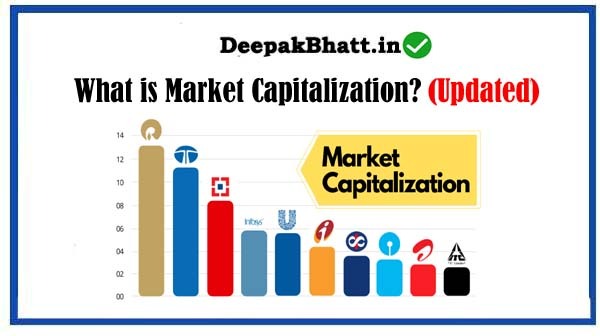Market capitalization often referred to as market cap, is the total value of a company’s outstanding shares of stock…
Calculated by multiplying the current stock price by the total number of outstanding shares.
This metric is a fundamental indicator that provides a snapshot of a company’s relative size in the financial markets.
Cash Flow Statement? Free Featurs & Types
What is Bull Market? Characteristics, Strategies
What is Bear Market? Features, Strategies
What is Liquidity? Features, Metrics & Impact
Calculation Methods
It can be calculated using the following formula:
Market Capitalization=Current Stock Price×Total Outstanding SharesMarket Capitalization=Current Stock Price×Total Outstanding Shares
Understanding the nuances of this calculation is crucial for investors, analysts, and financial professionals seeking to evaluate and compare companies in the stock market.
Categorizing Companies
It is commonly used to categorize companies into different size classes. While specific definitions may vary, companies are generally grouped into three main categories:
1. Large-Cap (Large Capitalization):
Large-cap companies are typically the largest and most well-established companies in the market. They often have market capitalizations in the billions or even trillions of dollars. Examples include industry giants like Apple, Microsoft, and Amazon.
2. Mid-Cap (Midsize Capitalization):
Mid-cap companies fall in the middle range of market capitalization. They are often considered to have moderate growth potential and moderate risk. The market capitalization of mid-cap companies generally falls between that of large-cap and small-cap companies.
3. Small-Cap (Small Capitalization):
Small-cap companies are generally smaller and less established compared to large-cap and mid-cap companies. They are often characterized by higher growth potential and higher volatility. Small-cap stocks typically have market capitalizations in the range of a few hundred million to a couple of billion dollars.
Significance
Understanding market capitalization is essential for several reasons, and it plays a crucial role in shaping investment strategies and decision-making:
1. Size and Scale Assessment:
Its provides a quick and effective way to assess the size and scale of a company in the stock market. Larger market cap generally implies a more substantial and established presence.
2. Risk and Return Considerations:
Investors often associate market capitalization with risk and return characteristics. Large-cap stocks are often considered more stable but may offer slower growth, while small-cap stocks may be more volatile but potentially offer higher returns.
3. Investment Style and Strategy:
Investors often align their investment style and strategy with companies of specific market capitalizations. For example, growth investors may be drawn to small-cap stocks with high growth potential, while income investors may favor large-cap stocks with stable dividends.
4. Market Index Composition:
It is a key factor in determining the composition of market indices. Indices like the S&P 500, which includes 500 of the largest U.S. stocks, are market-cap weighted, meaning companies with larger market caps have a more significant impact on the index.
5. Sector and Industry Comparison:
Its allows for comparisons within specific sectors or industries. Investors can evaluate how a company’s size compares to others in the same sector, providing context for competitive positioning.
Master the Basics of Finance for professionals Video Course
Business Finance Essentials Fundamental Concepts with Tutorial
Financial Ratios Practical guide For finance students
Market Capitalization vs. Enterprise Value
While market capitalization provides a snapshot of a company’s equity value, enterprise value offers a more comprehensive picture by considering both equity and debt.
Enterprise value includes the market value of equity plus the company’s outstanding debt, minus its cash and cash equivalents.
The comparison of market capitalization and enterprise value is crucial for assessing a company’s overall valuation.
Limitations and Considerations
Understanding market capitalization comes with certain limitations and considerations that investors should be aware of:
1. Limited Insight into Business Operations:
While indicative of a company’s size, provides limited insight into its business operations, profitability, or financial health. Investors should complement market cap analysis with other financial metrics.
2. Volatility and Investor Sentiment:
It is influenced by stock price movements, which can be driven by investor sentiment and market dynamics. Short-term fluctuations in stock prices can impact market capitalization.
3. Global Variances:
Market capitalization thresholds for categorizing companies as large-cap, mid-cap, or small-cap may vary across global markets. Investors should be aware of these variances when comparing companies from different regions.
4. Growth Potential vs. Stability:
While large-cap stocks are often associated with stability, they may have limited growth potential compared to smaller companies. Investors should align their investment goals and risk tolerance with the characteristics of different market cap segments.
Trends in Market Capitalization
1. Rise of Mega-Cap Stocks:
The term “mega-cap” has emerged to describe companies with exceptionally large market capitalizations, often exceeding $200 billion or even $1 trillion. The rise of mega-cap stocks reflects the dominance of technology and e-commerce giants.
2. Focus on ESG Metrics:
Environmental, social, and governance (ESG) considerations are gaining prominence in investment decisions. Investors are increasingly assessing companies based on ESG criteria, influencing market capitalization trends.
3. Technology and Innovation Impact:
Technology and innovation continue to drive market capitalization trends. Companies at the forefront of technological advancements, such as those in the tech and biotech sectors, may experience rapid changes in market value.
Conclusion
In conclusion, market capitalization serves as a vital metric in the toolkit of investors, analysts, and financial professionals.
It provides valuable insights into the size, valuation, and categorization of publicly traded companies, shaping investment strategies and decision-making.
As financial markets evolve and companies experience shifts in value, market capitalization remains a dynamic and essential element for those navigating the complexities of the stock market.

















